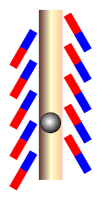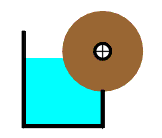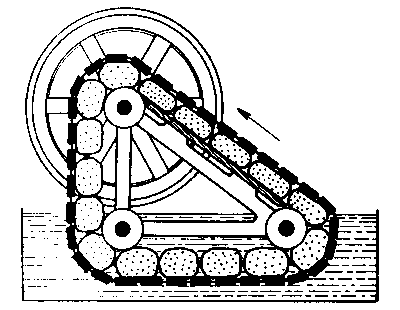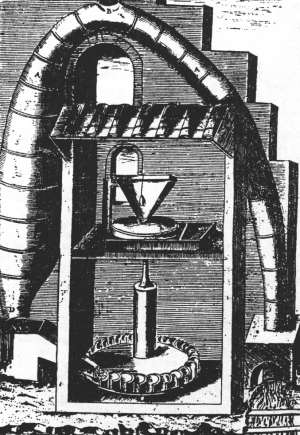
Pierre de Maricourt's magnetic concept
Perpetual motion machines need not be purely mechanical. Between the middle ages and the present time many devices have been proposed which make use of magnetic, hydraulic, electrical or other forces. And of course, often several principles have been combined in attempts to construct a successful perpetual motion machine.
The first known magnetic PM proposal dates back to 1269. Pierre de Maricourt (also named Petrus Peregrinus) described a rotating device which uses the attraction force of several magnets.

Pierre de Maricourt's magnetic concept
As magnetic effects were poorly understood at this time, this idea seemed plausible. Maricourt explained that he wasn’t proposing a machine to produce useful work, but rather a model to help understand how the planets move in their orbits. Here, the PMM is to be interpreted as a pure model or analogy of a natural phenomena. Pierre de Maricourt thought that the magnetic lodestone was the lapis for which the alchemists searched.
As often happens in the history of science, in the process of doing one thing, even doing something misguided, one discovers other things which are useful or important. Pierre’s goal of explaining planetary motion did not prevent him from discovering that little iron wires put onto a magnetic ball arranged themselves in lines comparable to the imaginary longitude lines of the celestial sphere. Pierre also observed that magnetic lodestones which were put on little swimming wooden pieces always aligned in north-south direction. Pierre de Maricourt coined the expressions of the magnetic "north" and "south poles" and he was the first who wrote that opposite poles attract each other and like poles repel.
 Frontispiece of the Mathematical Magick |
Bishop John Wilkins (1614-1672) who was a co-founder of the Royal Society, described in his book Mathematical Magick or the wonders that may be performed by mechanical geometry a simple magnetic PM, which was suggested by Johannes Taisnierus. At the upper end of a ramp a magnetic lodestone1) is mounted. The ramp has two openings; one which allows an iron ball to enter the upper ramp at the bottom and another hole at the top through which the ball can drop to a lower ramp which guides it back to the bottom of the upper ramp. |

Wilkins also provided an explanation, why this mechanism cannot work. Why
should the ball drop through the upper opening instead of eventually flipping
to the lodestone? Why should the ball on the lower ramp roll down against
the attraction of the magnet, if it does not on the upper ramp? How does
the iron ball find out that it must change the direction of movement at the
bottom end of the ramps?
These questions and the implied explanation can be found in many articles
and apparently is the most natural approach to deflate Taisnierus' idea.
If we do a careful analysis of the device in modern terms, we find out that
things are not so simple as they seem. Look at the forces which act on the
iron ball. Of course, the position of the magnet, the slope of the ramp and
the location of the openings must be carefully adjusted. To our surprise,
this device does not violate the law of energy conservation - but it does
violate the second law of thermodynamics!

Check this out and explain how it works!
| m | mass of the iron ball |
| f1 | attracting magnetic force at the lower end of the ramp |
| f2 | attracting magnetic force at the upper end of the ramp |
| fH | down force of the ball, |fH| < |f1| |
| fg | fg = m g weight force of the ball,
|fg| < |f2| ; thus the ball can drop through the opening in the upper ramp |
We should keep in mind that Wilkins was one of the first scientists who did a great step forward in science, as he replaced many speculations by experiment. However, this did not hinder him to make very witful considerations about the (possibly) living beings on the moon. It should take some more years until an Isaac Newton stated Hypotheses non fingo. John Wilkins' scientific work also addressed educated common people - an aspect which shall not be underestimated if we regard the common scientific culture in Europe at his time, most scientists communicating in latin laguage. Thus Wilkins can be named one of the fathers of modern science.
1922, a modern variant has been described by Prachar2). Here, an arrangement of magnets pulls a steel ball up. The ball is guided by a ramp or tube. Michal adds: "...where the problem of moving the ball back was not solved by the inventor." (p.139)

Prachar's solution with permanent magnets
in alternating arrangement
The existence of the modern SMOT shows, that bishop Wilkins' idea and the 1922 concept are attractive for todays inventors as well.
 |
William Gilbert (24 May 1544-30 Nov. 1603) was Elizabeth I's royal physician.
Moreover, Gilbert was the first to systematically study phenomena caused
by the earth's magnetism; he was the one who proved that the compass needle
always points to the magnetic north pole of the earth. At Gilbert's
time the reasearch of magnetic phenomena was thoroughly performed, as scholars
expected many new ideas and findings. But the theory of magnetic fields was
not developed and the hope to invent the PMM by using magnets was fed by
dreadful tales like those about the fate rock or magnet mountain
which ruined every ship coming too close by pulling out all nails due to
its terrible magnetic power. Gilbert's book De Magnete3) (1600) was widely read and extremely influential. Gilbert was no follower of pepetual motion concepts. Actually, in chapter XXXV, he cites some names and explicitly denies the possibility of these devices. |
Here's a machine which embodies the fallacies of the magnetic PMM. Occasionally
in cartoons or recreational physics we find drawings like this, which illustrates
how a magnet can be used to propel a ship or car. I don't know when this
idea originated nor if the concept ever was seriously suggested.

H.-P. Gramatke's version of the magnetic car
Some Jesuits, amongst them some of the most outstanding scholars of the seventeenth century, Athanasius Kircher (2 May 1601-30 Oct.1680) and his pupil Caspar Schott (5 Feb. 1608-22 May 1666) studied the creation of perpetual motion on earth by man's hands.
 |
Athanasius Kircher explored the effects of the magnetic lodestone, as William Gilbert did before him. The universal scholar Kircher seemed to have an ambivalent opinion about perpetual motion devices, which did not prevent him from inventing several PM machines. One of his constructions is a wheel with radial iron points rotating in the field of four magnets. Technically speaking, this was a further development of Pierre de Maricourt's idea. But the genius Kircher also did not succeed in inventing an operable PM device. |
In Schott's 1664 magnum opus Technica Curiosa we find not only descriptions of the sensational experiments performed by Otto von Guericke, but also numerous images and descriptions of the most recent perpetua mobilia of mid-seventeenth century. Not all of these devices were regarded as operable. Schott gives the example of a stunningly complex mechanism being invented by Johann Joachim Becher (Technica Curiosa, p.732). The elector of Mainz, Hans Philipp von Schönborn, even erected a tower to house the whole machine and set it into operation. The gigantic effort was performed to keep a clockwork running!

The machine's inventor closed his project after many unsuccessful years of work with the words: "Ten years I've pursued this foolishness, and have wasted much time, money and reputation, but I can announce without fame [sic] that the motus perpetuus is impossible."4) (cf. Michal, p.30).
Besides the best known members of the Jesuit order were others who fell addict to the search of perpetual motion:
Schotts Technica Curiosa contains so many references to Jesuits that one can easily get the impression that in the seventeenth century the whole Societas Jesu was infected by the perpetual virus.
A very simple PMM consists of a tubular ring filled with two liquids of different density. The difference of the levels is expected to provide an asymmetric force, thus causing the wheel to rotate. Unfortunately, the two liquids are always in balance, whatever the densities of the liquids are. This principle can be traced back to the year 1150 to Bhaskara's Siddhanta Siromani.5)

A two-liquid perpetum mobile
Even simpler is the next device. A wooden wheel is at one side only partially immersed in a water tank. The asymmetric buoyancy force was supposed to keep the wheel rotating. The inventor of this machine did not take in account that pressure in liquids always acts from all sides and exerts forces perpendicularily on the surface of the submerged object. This is a common misunderstanding about the way upward buoyant forces are generated. The wooden wheel proved to be a perpetuum stabile, which is not surprising at all.

Buoyancy perpetuum mobile
Denis Papin (22 Aug. 1647 - 23 Jan. 1712) was a French physicist who made
the first reasonable designs for steam engines. He also invented the steam
cooker (pressure cooker). Papin suggested the simplest hydraulic PM one can
imagine. It had no moveable mechanical parts and its function should be based
on the pressure excess in the large container that forces the liquid column
in the thin tube upwards.
A similar suggestion was made by Robert Boyle (25 Jan. 1627 - 30 Dec 1691),
who thought that a very narrow bore tube would allow a liquid to rise continually
by capillary effects. Although both concepts frequently are illustrated by
the same schematic image, their intended principle of operation is completely
different. Nevertheless, none of these ideas worked.
 |
 |
|
Violation of the hydrostatic equilibrum |
Papin should have known better. Years earlier, the french philosopher, physicist and mathematician Blaise Pascal (1623-1662) invented a device to measure the hydrostatic pressure. This device even today is named after its inventor Pascal's apparatus(?). But long before both, Simon Stevin made first experiments of this type. Cf. Recknagel, Experimentalphysik p.68. |
Later engineers tried their luck with buoyancy PMMs based on other principles. In the apparatus shown here, the inventor understood that the liquids in the two tubes of different length were in hydrostatic equilibrum in the two tubes. But he thought he could still exploit the unequal heights to maintain motion of something else. Let's examine the intended operation of this machine! The U-tube contains two liquids of different density (say water and mercury), which are in static equilibrum. The balls are light enough to rise in both liquids. A single ball rises in the left part of the tube, pops out and falls down. With this, it drives a wheel which can provide useful work. Then the ball drops onto the top of the pile of balls in the right hand part of the tube. The pile is heavy enough to force the lowest ball under the deepest point of the U-tube. Thus, the lowest ball will be free to rise in the left tube. It's not easy to explain in simple terms why this cyclic process cannot work.

An almost workable hydraulic-
mechanic perpetuum mobile
William Congreve (20 May 1772 - 16 May 1828), an English officer who introduced rockets onto the battlefield, made a drawing of a PMM working by capillary effects in sponges. The principle of operation is simple: the sponges on the left hand side fill with water and get heavier. In this way a downward force arises which keeps the chain moving in counterclockwise direction. The sponges which rise at the right hand side are squeezed by the pressure of the heavy chain-plates (therefore they weigh less). Congreve calculated the considerable power his machine could generate. But alas! Although this is a clever design, it does not work.

Congreves sponge perpetuum mobile
Based on ideas of Giovanni Battista della Porta (1535-1615), the italian renaissance engineer Vittorio Zonca (1568? - 15 Nov 1602) invented a PM that used the effect of the siphon. Siphons only work when the outlet opening is lower than the inlet. At Zonca's time this fact was not correctly known which made the construction seem to be a realistic option to obtain a perpetual energy source. Look at the strange belly shape of the siphon! It is not caused by poor skills of the draftsman, but by the idea, that a larger cross-section at the outlet will compensate the lack of height. The whole idea seemed plausible, as the siphon effect was not explained by air pressure but by the aristotelian horror vacui. I.e. nature "abhors a vacuum", meaning "nature cannot produce a vacuum."

Syphon perpetuum mobile
Besides the famous radium clock many other electric PM devices were invented. One of the earliest examples is based on the electric charge generated by two Zamboni elements (a type of dry battery). As the mechanism needs only little power, it ran very long. Ord-Hume reports from a device that was set into motion around the 1840s and lasted for 150 years.
 |
 |
|
| Electrostatic perpetuum mobile The galvanic batteries are concealed inside the columns |
A different device based on the same principle. It was not intended to be a PM at all! This sensitve instrument was used in the laboratory to check electric charges. As there was already pre-charge applied to the electroscope, an additional little charge caused reaction. Only the adjustment had to be set correctly beforehand to prevent the electroscope from oscillations. Cf. Recknagel, Experimentalphysik p.489. |
Machine inventions which use electric motors mechanically coupled with generators and some electric trickery are abundant. As electric and mechanic power can be converted into each other, these machines worked as well as their mechanical equivalents, the recirculation mills. In mechanical mills there are friction losses which can't be avoided - in these electromacnetic machines we find resistance losses. So this also proved to be the wrong way to get a PMM running. But this knowledge is not so widely spread as one may expect, as is demonstrated by Don Martin's corner-ring generator.

Electric motor & generator perpetuum mobile
| M | electric motor |
| G | generator, mechanically driven by M |
| LS | charge and control electronics |
| A | accumulator |
| ...next chapter |
1. Natural magnetic lodestones were often
"clad" within iron balls for experimental purposes.
2 Prachar, F.:
Jak jsem hledal a nalezl perpetuum mobile (how I searched and
found the Perpetuum Mobile)
Prague, 1922
Prachar was one of the PM inventors who published his book on own cost. Besides
the predecessor of the SMOT, Prachar describes many machines which make usage
of permanent magnets. But also variants of the classical overbalanced wheel
can be found. The most remarkable invention by Prachar is a PM that uses
the "frictional forces" of the bearings to power his construction!
3. The full title of Gilbert's book reads: De
Magnete magnetisque corporibus et de magno magnete Tellure physiologia nova
It stimulated both science and pseudoscience. The notion of animal
magnetism gave rise to the Mesmerists who thought that magnets
could cure diseases.
4. Original German text by Johannes Becher:
"Zehn Jahre bin ich auch mit dieser Narrethey umgegangen, viel Zeit, Geld
und Reputation darüber verloren, doch darf ich ohne Ruhm zu melden,
daß ich sagen kann, daß der Motus perpetuus unmöglich
sei."
5. S. R. Sarma, Astronomical Instruments in
Brahmagupta's Brahmasphutasiddhanta, Indian Historical Review, XII 1986-87,
p. 69-71) and Perpetual Motion in Machines and their Design in Ancient
India, Physis - Rivista Internationale di Storia della Scienca, vol.
XXIX (1992) fasc. 3 p.665-676.
| Last update: 22 May 2004 / |
|